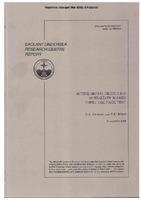| dc.description.abstract | The use of active sonar in shallow water results in received echoes that may be considerably spread in time compared to the transmitted wave form. The duration and structure of the spreading and the time of occurrence of the received echo are unknown without accurate knowledge of the environment and a priori information on the location and reflection properties of the target. A sequential detector based on the Page test is proposed for the detection of time-spread active sonar echoes. The detector also provides estimates of the starting and stopping times of the received echo. This signal segmentation is crucial to allow further processing such as more accurate range and bearing localization, depth localization, or classification. The detector is designed to exploit the time spreading of the received echo and is tuned as a function of range to the expected signal-to-noise ratio (SNR) as determined by the transmitted signal power, transmission loss, approximate target strength, and the estimatednoise background level. The theoretical false alarm and detection performance of the proposed detector, the standard Page test, and the conventional thresholded matched filter detector are compared as a function of range, echo duration, SNR, and the mismatch between the actual and assumed SNR. The proposed detector and the standard Page test are seen to perform better than the conventional thresholded matched filter detector as soon as the received echo is minimally spread in time. The use of the proposed detector and the standard Page test in active sonar is illustrated with reverberation data containing target-like echoes from geological features, where it was seen that the proposed detector was able to suppress reverberation generated false alarms that were detected by the standard Page test. | |
